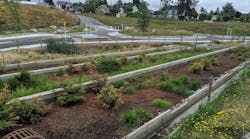Editor’s Comments: Buffalo Soldier
By Elizabeth Cutright
By morphing from temporary, seasonal challenges to perpetual—seemingly never-ending—problems, drought and increased demand have forced many states to take preemptive action. July may be Smart Irrigation Month, but in many communities managing and monitoring outdoor water use is now a permanent, full-time job. In Los Angeles, for example, June 1, 2009 marked the beginning of mandatory conservation restrictions designed to reduce city water use by 15%. For those who love their green lawns, these restrictions mean that their sprinklers can only run Mondays and Thursdays, with enforcement to be handled by the city’s “drought police.” A new policy in Durham, NC, restricts homeowners to lawn watering three days a week based on their address. Durham’s new regulations also require rain sensors or soil moisture sensors for all newly installed automated irrigation systems, while existing systems must install sensors by November 30, 2009. Meanwhile in San Antonio, agricultural and residential irrigation are bracing for “Stage Three” restrictions that will limit sprinkler irrigation to once every two weeks, and allow drip irrigation only between 3-8 a.m. or 8-10 p.m.
Clearly, irrigation restrictions are an important part of water resource management—especially when these restrictions come on the heels of extreme drought. These mainly municipal irrigation restrictions are certainly laudable and exemplary actions, but agricultural and commercial users must also be included in any regulations in order to substantially control the impact of irrigation on water resources. In California, these big water players are known as “water buffaloes,” and are primarily comprised of agribusiness, as well as large urban centers and commercial interests. Focused on keeping the water (and the money) flowing, sometimes the needs of these “water buffaloes” seem to trump the needs of the community as a whole.
In fact, it’s a dilemma many water purveyors face: how to balance urban and agricultural water needs, while protecting and maintaining environmentally delicate water sources. For an example of what happens when the urban and the rural collide, one need look no further than California’s Sacramento Delta. The situation in the Delta illustrates just how difficult it is to manage competing demands while protecting a finite resource.
In California, there has long been tension between the relatively water-rich north and the arid south. Surrounded by desert and charged with supplying water to dense urban areas, southern California depends on remote water sources to meet demand. In fact, almost 20 million state residents get at least some of their water from the Sacramento Delta—a small patch of land in the north where the ocean and rivers meet. But the Delta provides more than just drinking water; its resources support a large chunk of California’s agribusiness, and it just happens be the home of the endangered Delta Smelt. Unfortunately, the Delta is under siege—not just from urban and rural consumers, but also from rising sea levels and never-ending drought.
It’s a precarious situation, and the Delta’s survival depends upon how the parties involved will manage competing demands and interests. Recently, Governor Arnold Schwarzenegger’s administration came up with the Delta Vision Blue Ribbon Task Force in an attempt to develop a workable plan to protect the Delta and maintain the state’s water supply. The current Task Force suggestions include using recycled water for irrigation and industry, the construction of additional desalination plants, and new infrastructure in the form of reservoirs and peripheral canals. The Task Force also calls for stricter oversight of water rights permits to insure that the agricultural industry is not using more than its allocated water share. A recent panel recommendation seems designed to stir up the drama by proposing that the state begin construction of a canal to divert water from the Sacramento River as soon as 2011.
Considering that agriculture accounts for 70% of water use, it behooves us all to stop and listen to what our farmers and growers have to say. Especially when experts estimate that in order to meet food production demands in 2025, agribusiness will require 100% of the amount of water currently provided by the Colorado River. The contention and acrimony that already exists surrounding water rights along the mighty Colorado mimics the situation in the Delta. Whatever the solution, it’s not going to be an easy fix.
Although it may appear at first that municipal water providers and the agricultural industry operate in two separate universes, their mutual dependence on a safe, clean, and reliable water supply binds them together—one cannot operate without considering the actions of the other. It’s often said that water is a shared resource, which makes me wonder if the current balkanization of our water supply—that clear demarcation between agricultural interests and municipal interests—makes sense. Isn’t it about time we present a united front against the challenges of scarcity and demand?


